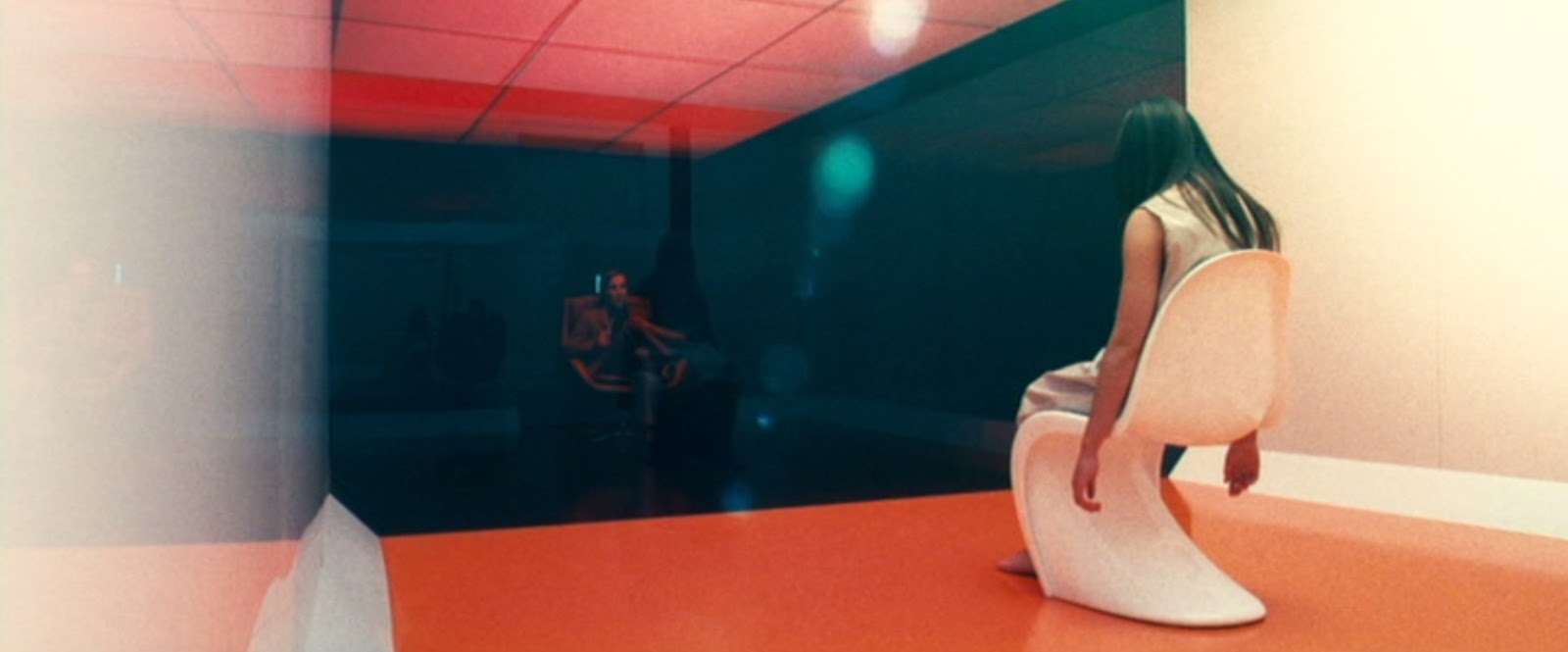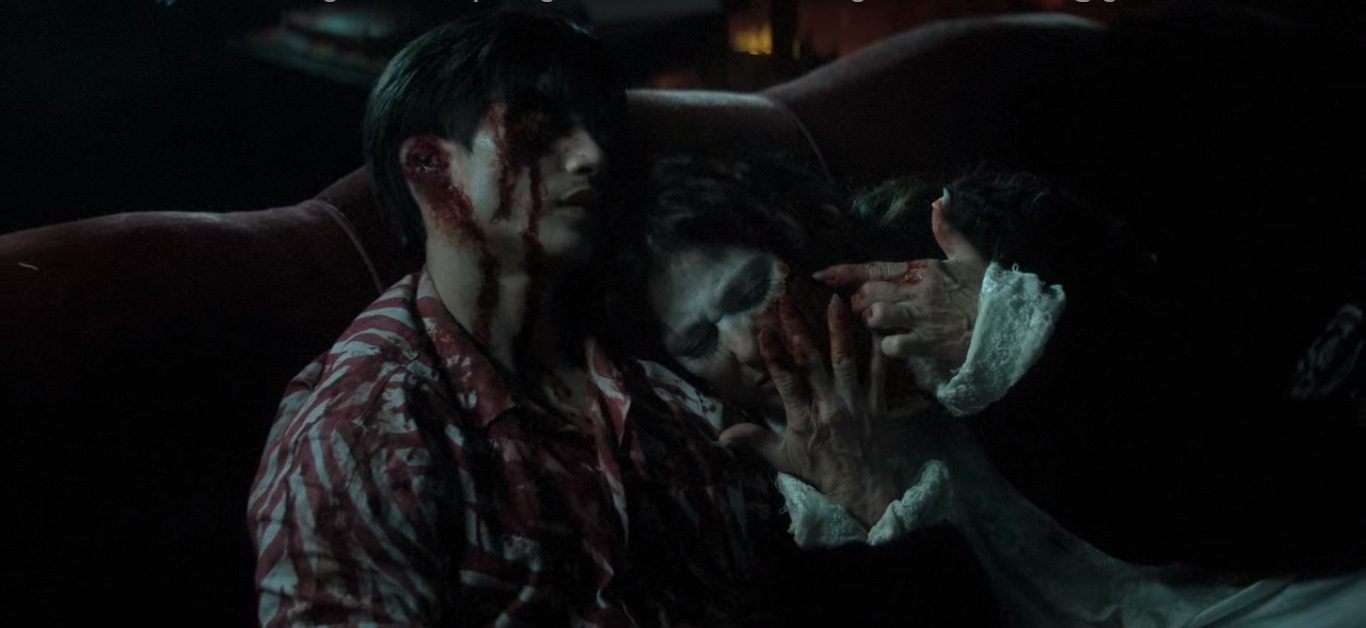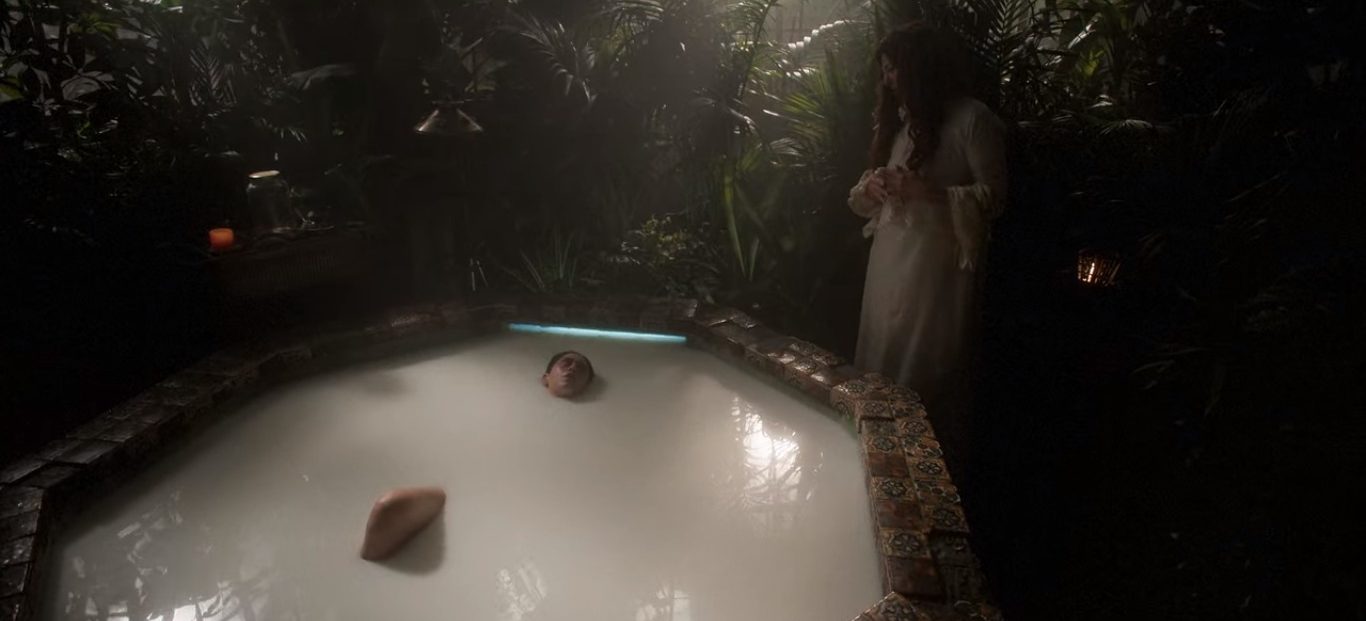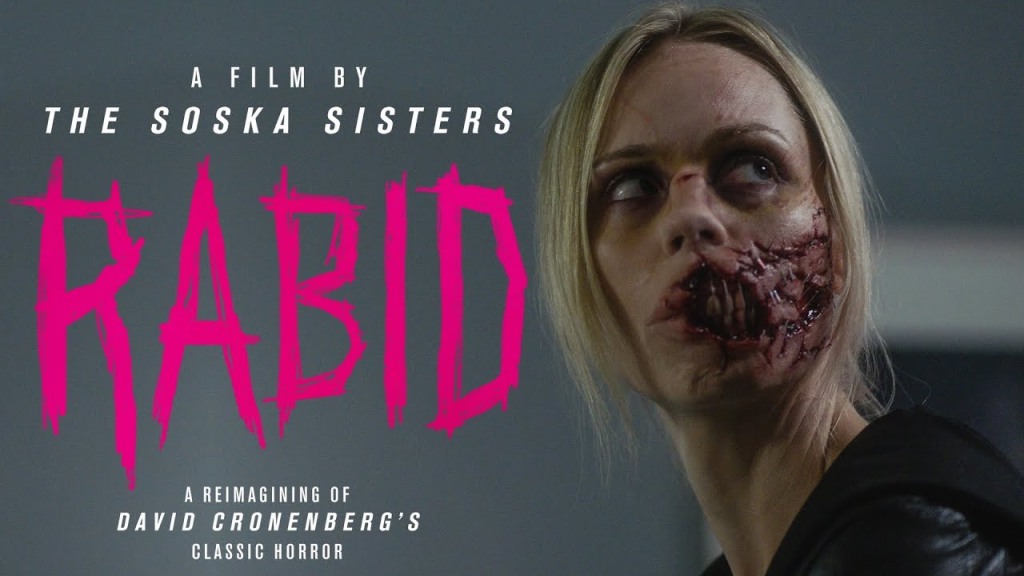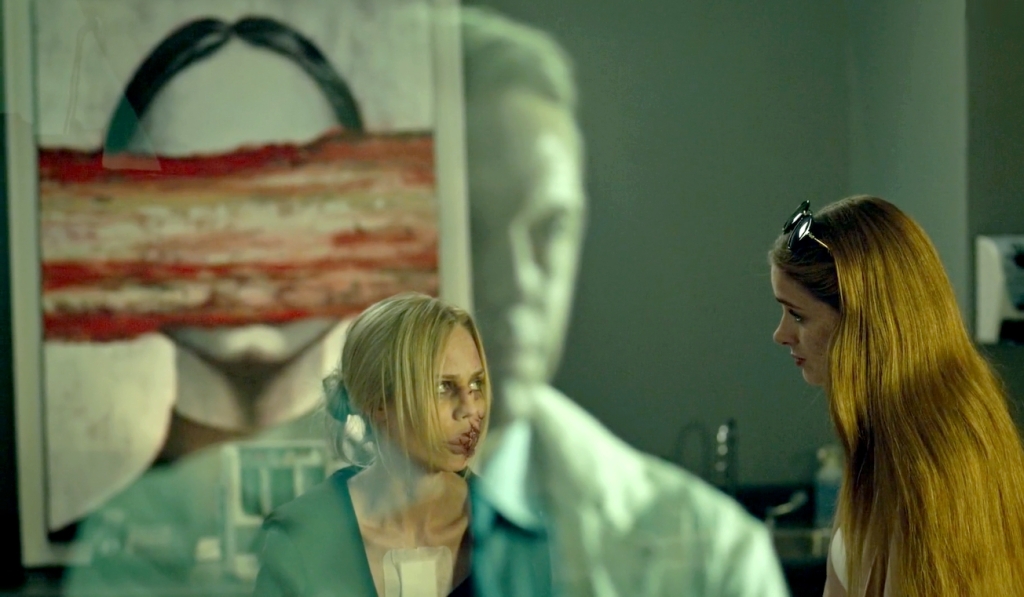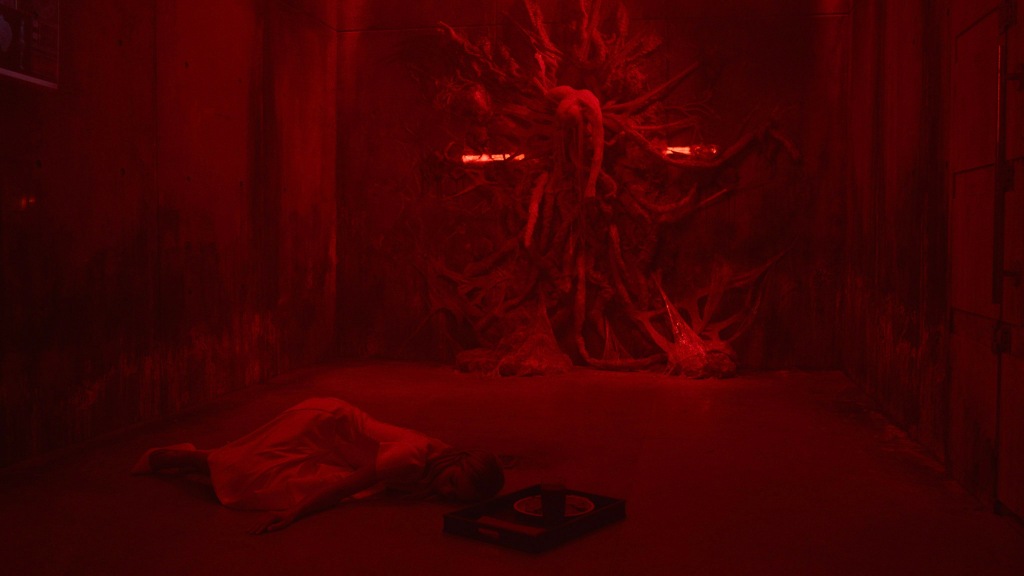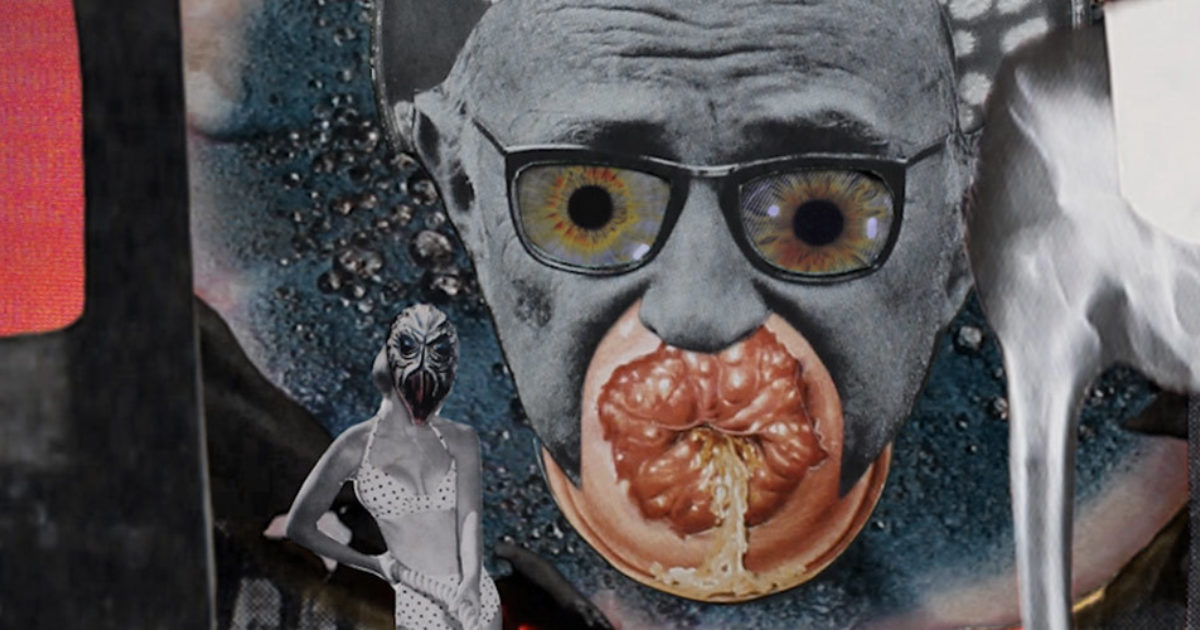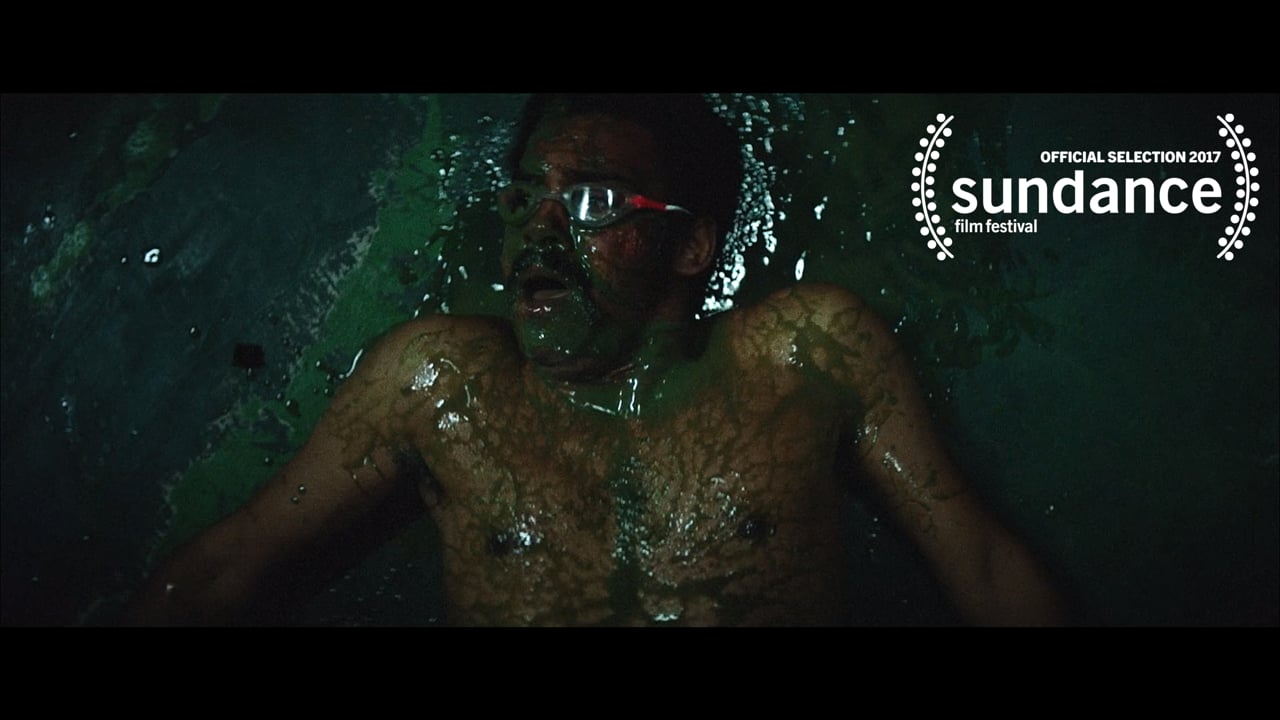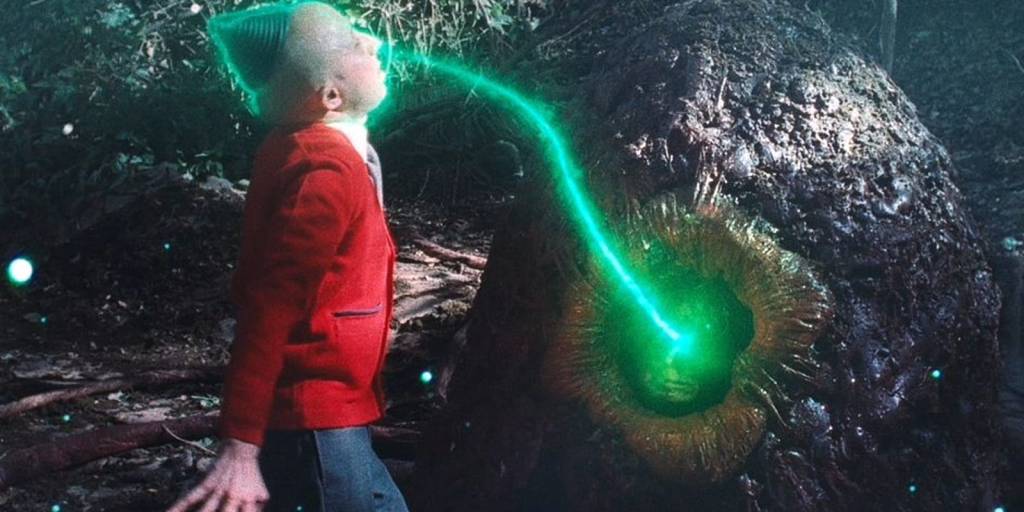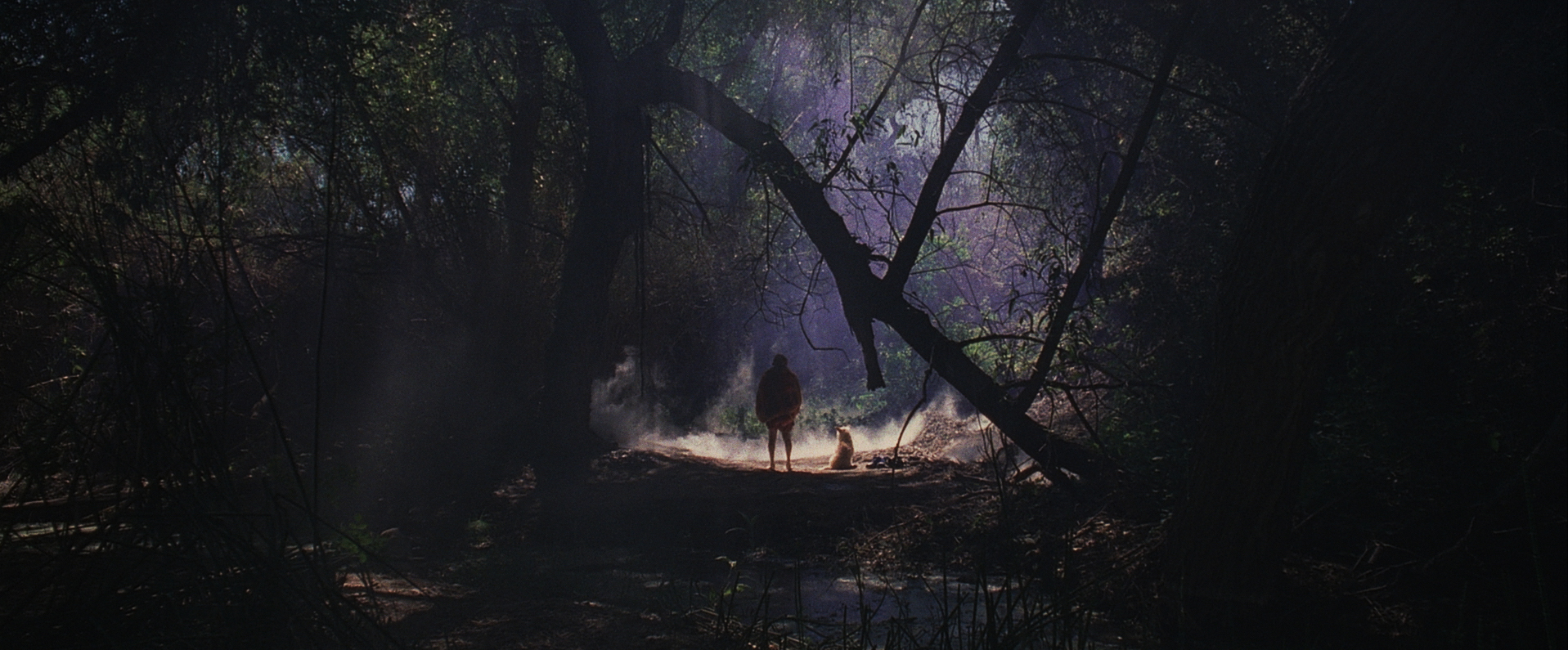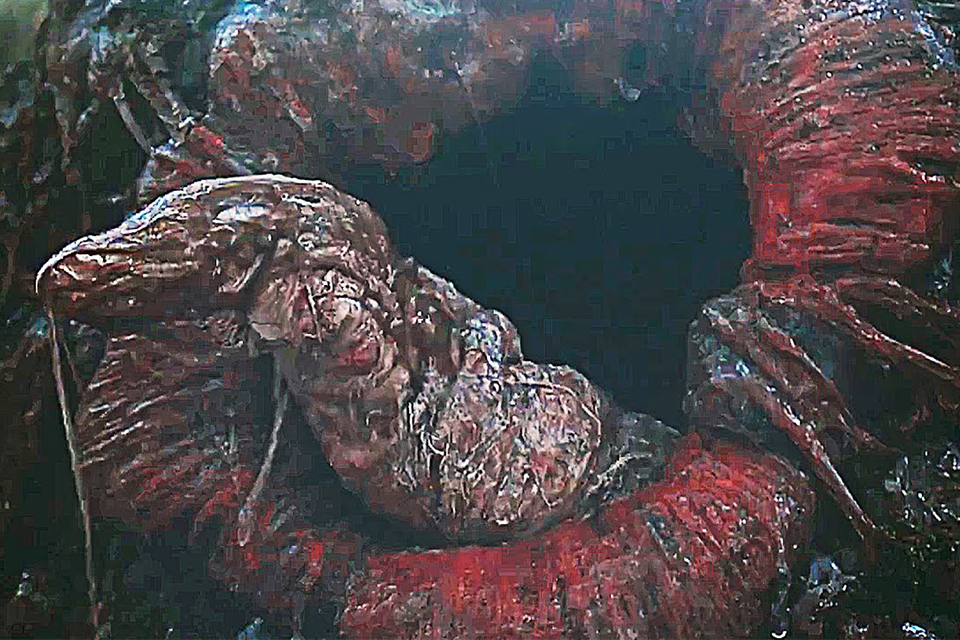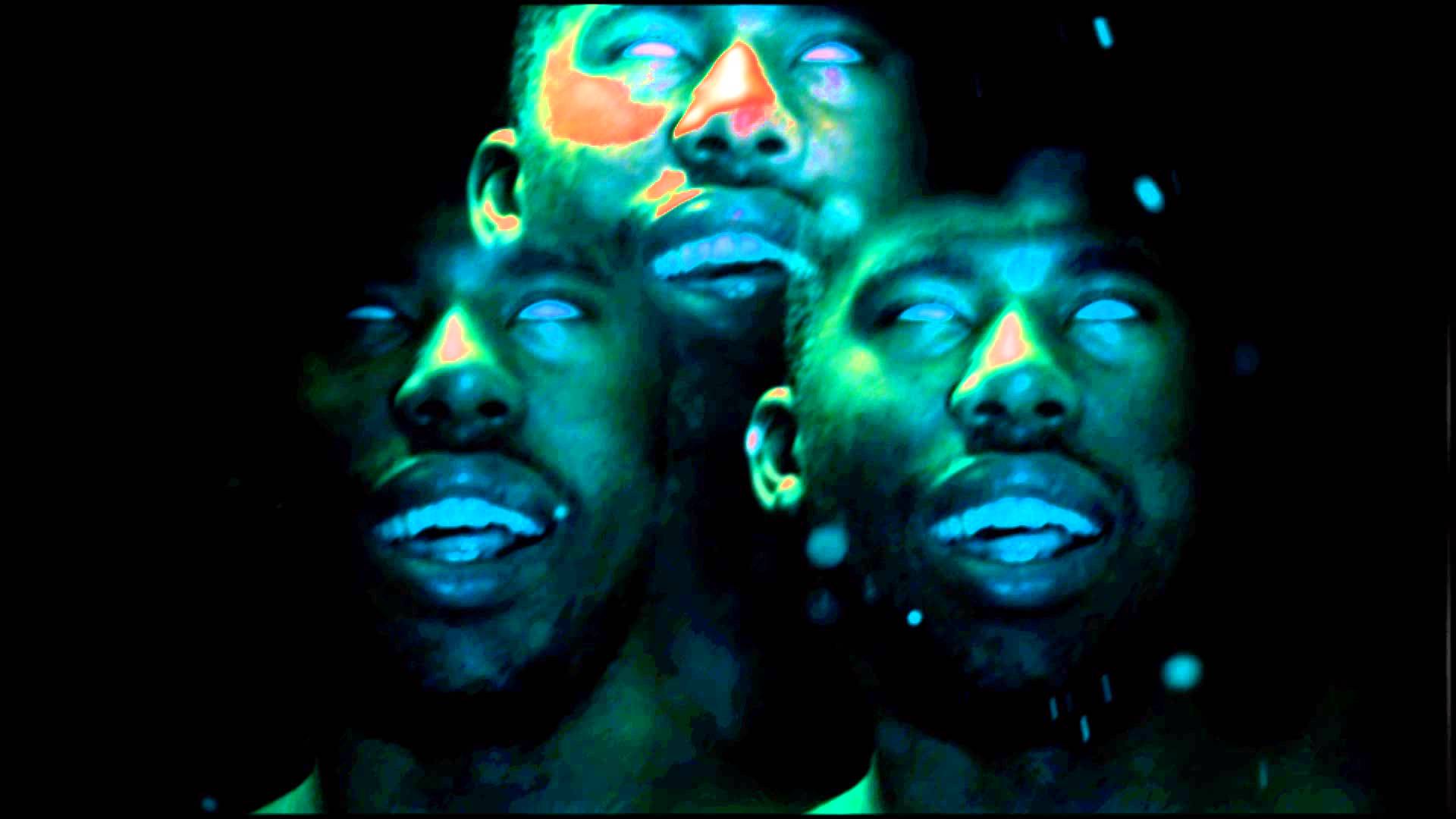
BEYOND SCIENCE
BEYOND SANITY
BEYOND CONTROL
I think one should dedicate more thinking to the various cinematic build environments, the iconic pop cultural institutions and fictional modernist architectures hosting “the Beyond”. There are many instances of cinematographic altered state eeriness and paranormalcy that have an actual headquarters. There is a plethora of recent examples starting with Alex Garland’s massive wild nature surrounded mansions (actually Norvegian hotels) in Ex Machina and remote and secretive quantum computing facilities (DEVS series). Even more recently, Netflix TV horror series Archive 81 presents an archivist painstakingly reconstructing a series of burned VHS 1990s tapes inside a remote 1980s brutalist ‘medialab’ situated in the wilderness of Catskill mountains, employed by an opaque LMG corporation.
I want to retcon this older article — in the light of so-called Tartaria conspiracy — basically, a QAnon architectural (hyperstitional) conspiracy that sounds a bit like the Mandella effect but focuses on built environments, of their perceived ‘erasure’ 19th c historicist buildings by modern counterparts, a longing for a lost imperial grandeur and the pop-up fairgrounds (Potemkin Village) that have characterized International World Exhibition or Colonial Fairs and the like (based on a detailed article by Zach Mortice).
This nostalgia for past sumptuous interiors and expensive construction materials coincides with what was perceived as the impersonal, cold, and abstract allure of modernist housing or architectural project stranded in a wasteland of prefab, post-war white suburbia. Modernist housing as a place of corruption, conspiracy, and malaise is somewhat paradoxical and Ballardian late XX and early XXI construct — as modernist inexpensive housing was initially meant to break free of the inherited privileges of high bourgeoisie and aristocracy. They also signaled a new move towards affordable housing, welfare and a break from the inhumane living conditions of the working class and urban poor in 19 c industrial towns. Modernist architecture, in its finest expressions, was a direct critique of the deadening hypocrisy of previous historicist styles, the perceived wastefulness or eclecticism of previous eras (including High Imperialism) be it Victorian houses or numerous revivalist examples (Gothic, Neoclassical, Renaissance etc).
Cinema history starting with noir style movies from the 40s and 50s adopted German Expressionist formal principles, the ‘painting with light’ in the words of John Alton — to make modernist American houses and architecture the backdrop of anomie, high-level corruption, consumerism, true dens of vice of mid XX century US capitalism. This has been amply documented by Thom Andersen in his 2003 video collage essay Los Angeles Plays Itself — hommage which I have been reviewing for Timespacewarps. That being said, I did not intervene too much in the text below (if you find the time and got the patience to read it) please bear in mind that such think-tank dystopian representations in SF movies of corporate or private spaces obscure a longer history of modernism and its roots that were associated with both socialist and working-class progressive politics of urbanism and city planning (especially in Europe in its early German Bauhaus, Soviet and Austrian Red Vienna phases). Although there are obviously important exceptions like — the Fountainhead book and movie demonstrate — that focuses almost exclusively on the architect and architecture as a sort of virile suprematist ideal.
In order to generically trace these institutes and buildings I am going to an older 2010 classic – a definite cult psychotronic (Canadian) favorite: Beyond the Black Rainbow. It’s a fantastic directorial debut by director Panos Cosmatos and a movie that is more than 10 years yet does not feel dated even if he is probably more known for directing Mandy (2018). That is probably because it is a movie built around a sort or latent-future VHS artefact, one you might find discarded at a yard or garage sale, or one digitized by the LA art collective Everything is Terrible! that actively reedits, samples and digs into a seemingly endless infodump of US home video oddities. Beyond the Black Rainbow feels like a ‘found footage’ or even better a ‘found movie’ that somehow should have been made in the halcyon days of scifi/horror direct-to-video 1970s-1980s. It is a movie that never got made, or a movie that we weren’t allowed to watch as kids at the time (perhaps like Panos Cosmatos and his Video Attic childhood experiences). You can make your own list of cherished references and still it stands on its own. It is early Cronenberg Stereo/Crimes of the Future, early Lucas THX 1138, spaceage Kubrick. Include Michael Mann’s 1983 The Keep, Ken Russel’s Altered States, Carpenter’s Darkstar, even some David Lynch thrown in there, Tarkovsky’s Solaris, Stuart Gordon’s From Beyond, Suspiria by Dario Argento, E. Elias Merhige’s Begotten as well as recent classics such as Gaspar Noe’s Enter the Void (2010) or Daft Punk’s Electroma. This treasure trove is supplemented by cult movies as Phantasm 1979 making it a hidden index of all those incredible indie horrors and thrillers exploring weird alternate realities and possible futures.
Beyond the Black Rainbow 2010s is as hyper designed as PHASE IV by Saul Bass (1974) – a truly incredible movie about the rise of mutated, superintelligent social insects (ants) and the birth of a new, hybrid, hivemindfull humanity, that emerges out of these inhuman assimilation processes and transformations. The final ending scene of PHASE IV (that got cut out initially) could also be a missing part from Beyond the Black Rainbow. It features a long sequence in which the human heroes seem to emerge out of a sandy anthill to unveil themselves as chosen Adam&Eve of the new-hive swarm symbiosis. It contains a lot of new age elements but somehow pushes them into a somber, scientistic and utterly stark and scarry transhumanist territory. It looks almost like a promotional video for a new human-swarm-insect utopia blended with desertic Dune ecology. The esper psy theme made me think about the heyday of psi manga/anime masterpieces. Elena, the psy prisoner of Arboria Institute is almost like a government special op child – featured as the “Esper” military-industrial experiments of AKIRA (1982-1990) or social housing conditions, isolation and devastating psychic battles of DOMU: A Child’s Dream (1980-81).
Music-wise and sound-design wise it is also a treat. Forget the ost 80s synth renaissance driven by Drive (one year later than Beyond the Dark Rainbow by the way) and check Jeremy Schmidt (aka Sinoia Caves, aka space-rocking Black Mountain) using a lot of vintage analog kosmische synth gear – extensive use of Mellotron, Korg Cx-3 organ, Moog Taurus bass pedals etc in one of the best scores I’ve ever encountered (will get back on that).
As an avid stalker at Mind, Body & Spirit festivals in Bucharest, a small collector of hypnosis& mind electronics tapes and DIY psychotronic weapons forger, I was surprised to finally find a movie that not only boldly reflects on subjectivities forged in the Century of the Self (Adam Curtis’s convoluted convergence of psychoanalysis/propaganda/public relations/human potential movement/self motivation/marketing focus groups), but attunes them to Lovecraftian brand of LSD-tinged forbidden knowledge & cosmic dread. It starts with an opening sequence of a promotional film made somewhere in 1960s by the Arboria Institute founder – Dr. Mercurio Arboria ( (played by Scott Hylands) that is also author of the “BE YOUR SELF” textbook featured at some point. We are watching a video cassette clone of the suicidal post-Heaven Gate Earth Evacuation plan, everything is presented in bright galactic colours and mesmerizing sounds, with a calm and relaxing voice bathed in a typical gritty pre-digital style kind of video hypnosis tape full of rustling forest trees, talking guru head, cosmic transcendental (corporate?!) memes and a grand crystallographic finale with the good but sinister Dr. Arboria fusing with a glowing pyramid. Apparently movie director Panos Cosmatos really based this movie on an unrealized installation, a sort of fake- mockup Institute/ intervention in the street window of an abandoned shop in Vancouver where he could actually put out pamphlets written by friends.
How does the beyond gets instituted, how do such institutions get filmically instantiated?
I think that Institutes tend to live in another dimension completely. They are objects that inhabit this twilight zone of radical experimentation bordering with both perfectly legal as well as illicit. In today’s catastrophic epoch, Institutes have a propensity for disaster-prone research & development. As gated and unaccountable think tanks or welcoming research institutes, their shadowy meetings, boards of directors are always beyond the reach of the public. They can work as incubators of shareholder or (newly) so-called stakeholder capitalism (driving the stake through the hearts of the people), and their influence gets described as vast lobbying powers that shape politics from afar while ignoring public opinion, thus giving architectural form to conspiracy theories born out of toothless institutional critiques.
In a way, I consider myself a tiny part of their virtual existence of these institutes, or at least in my benign prankster capacity – a potential twilight member thereof. It is as if these fictive institutes have been using their cinematic notoriety to usurp or subvert real institutional and disciplinary boundaries not only in matters of research/work/bioethics but also by making us live and experience ‘grey areas’ where mindfulness, wellness, sponsoring prosper. These are the exteriors and interiors of a recently sanitized military-entertainment carcass. Rarely do institutes get a mark – beyond a symbol or a logo. They are non-representational places, banal incubators of predatory financial techniques, corporate dealings, pyramid schemes that mostly end up in the press only after a scandal.

The ultra-modernist Arboria Institute is really the main character of the movie, setting its visual characteristics, pace, mood and conceptual magnetism by being a sort of architectural and physical extension of the barely human Dr Barry Nyle (played amazingly by Michael Rogers) head of research, and a protege of Dr Aboria. Dr Barry Nyle is the main hellraiser of the story and his Institute is not dark or brooding, but a brightly lit, pulsating, transparent, high tech ‘smart’ environment (before smart was invented – the action takes place in anno 1983). It is by no means a Lovecraftian space – full of oozing, chtonian, primordial slime but completely aseptic, reflective, transparent and celestial.
Hermetic rooms and labyrinthine structure reflect both the doctor’s mental corridors as well as the kind of futuristic kaleidoscopic mindfullness this Institute is supposed to promote. So what was the Institute promoting or offering in its own word? Again, this is not the kind of Shining hotel, pregnant with a haunted past, built on top of an indigenous cemetery, but fat with a grandiose dystropian-transhumanist future. However, at some point, we get a hint that there is something behind the transparent, shimmering interiors. A backdoor where the actual maintenance and care-work or low payed jobs by immigrants are taking place, the moment Elena finally manages to escape the Arboria trap – she enters a sort of normal kitchen where loud Mexican music & radio is playing.
To me Dr Barry Nyle looks like a demented Professor X gone completely wacko in the search of new X-Men recruits or even THE one mutant. I also love the fact that his humanity is somehow a cross-dressing act. In order to function, to reintegrate into his research, he has to mimic ‘normality’. His ‘humanity’ is most evidently propped up by costume and cosmetics (or ‘appliances’ as his wife calls them) – such as wigs or contact lenses. With repetition and daily rituals he is pasting over his radical ‘difference’, he is most of the time (until his final and last metamorphosis) perfectly hiding like the They Live extraterrestrial under an exterior. Yet this exterior is itself pretty skewed, more frightening than his actual visage. This trick does not work, in fact it enhances the enormity of his travesty.
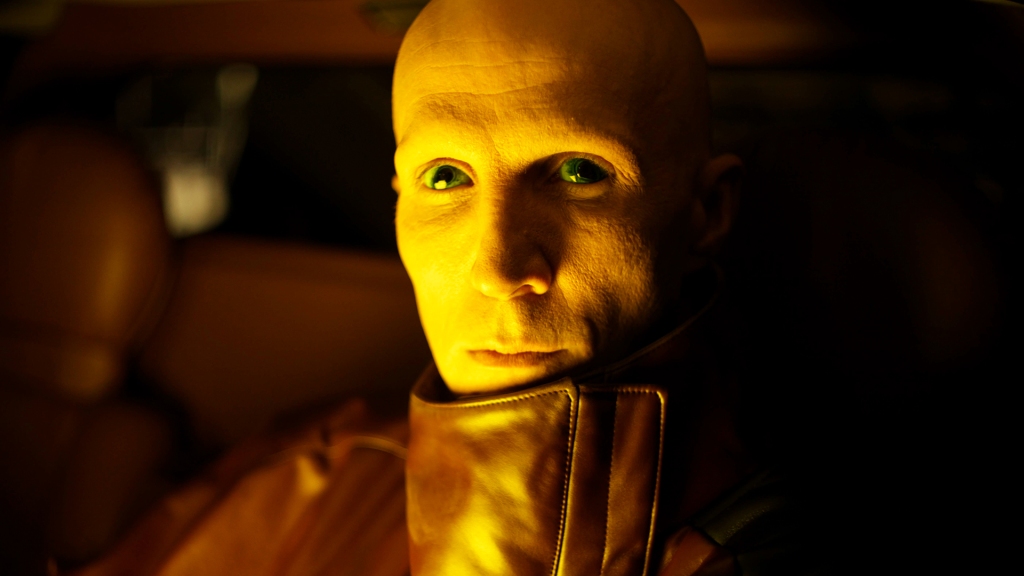
His bouquet of therapeutic mindfulness wonder techniques are (more obvious than ever) tailor-made for today’s self-exploitation, fatigue society and value-extraction (or extortion). “Happiness, content and inner peace” are on the lips of the founding figure yet this institutionalisation of improvements and actualization is the problem. The Arboria Institute is in his words: “… worldwide… at the forefront of neuro-psychology and new therapeutic technologies…”. “…[B]enign pharmacology, sensory therapy and energy sculpting” – all these new tools are there to guide the needful and paying clientèle. His mantra sounds like the bland sales pitch of a Silicon Valley founder or transhumanist in search of ultra rich CEO sponsorships. The state-of-the-art facility and the geodesic Biosphere gardens (based on The Bloedel Floral Conservatory and aviary in Vancouver, British Columbia) seem to distillate enhanced cognition and heightened sensory experience into a better and brighter future. Here I would say Beyond the Black Rainbow meets another favorite of mine (although with a completely different mood, texture and aestethics) ; the 1993 Ozzie splatterstick BODY MELT directed by Philip Brophy (a true predecessor to the Crank movies). BODY MELT is also framed by a sort of porno-Pharma wellness farm – a sort of biopolitical regime of the Pharmacopornographic Era magnificently theoretized in Testo Junkie by Brazilian contemporary writer and philosopher Paul B. Preciado.
Here is a 1990s imaginary experimental institute offering free samples of various pharmaceutical supplements to local, white, middle-class residents and dedicated clients of Melbourne. The Vimuville facility is maybe a more grotesque body horror counterpart of Arboria Institute, from the helpers and handyman employees they are not under control but testosterone-enhanced bodybuilders bodies with high-pitched helium voices. Yet Vimuville also features a fabulous introductory promotional video + branded Big Pharma products promising revitalization & natural good health trough state-of-the art health & leisure that are getting fairly close to Arboria’s mission statement. Needless to say, insiders at the institute as well as the (ignorant) human test subjects are all falling prey to the mutagen and hallucinatory capabilities of the new all-powerful-experimental porno-pharmaceuticals with various destructive results such as: tentacled meat-flowers pregnancies and sentient placentas, exploding penises, elongated serpentine tongues, living moving snot and many other exquisite body horrors. Body Melt reaches the video stalls at the moment when Zoloft, Prozac and a bunch of other mood enhancers hit the market.
In contrast with BODY MELT, Beyond the Black Rainbow somehow chooses to mostly keep out of sight (but not out of mind) the brutal and horrific mindbody effects of its pharmaco- neuro- enhancement technologies. Both JG Ballard and early Cronenberg come to my mind as investigators of the dark and radical potential of institutes and experimental life research facilities. Fictional psychoterapist Hal Raglan (The Brood 1979) who runs the Somafree Institute and wrote the Psychoplasmatics textbook “The Face of Rage” promotes a sort of primal scream, confrontational, -letting go of your suppressed emotions technique. He manages to induce what are bodily transformations, physiological changes, uncontrollable mutations and a new breed of children. All these all the breed of a newly pro-Life anti-abortion laws conservative consensus at the end of the 70s that is violently attacking abortion clinic s and physically endangering both patients and terrorizing their doctors.

Again, we have numerous other examples built environments in Cronenberg’s early movies, such as the experimental clinic of Dr Dan Keloid from the Keloid Clinic specializing in plastic surgery (Rabid 1977) as well as Dr Luther Stringfellow’s and his human-socio-cybernetic experiments at the sanatorium of the invented Canadian Academy of Erotic Inquiry (Stereo 1969). Reflections of the cold war think tanks, high weirdness laboratories or corporate para-scientific incubators, they unleash unpredictable evolutionary outcomes, beyond-human infestations, induced telepathic, sexual energies & out-of-control tests.
The Black Rainbow’s trajectory jumps from this New Age Esalen-like beginnings to a well-established (and prosperous) early Silicon Valley future present situated in 1983. The ALIEN(1979)-like opening titles feature a red magmatic date that lits up slowly and eerily out of a pitch-black background. The title sequence is played on top a impressive cosmic drone reminding me of Robert Rich’s “Hayagriva”(Trances album) (on youtube), one of my favorite sound pieces ever (really played it in a loop for hundreds of times), incidentally also made in 1983.
What is common to both BODY MELT and Beyond the Black Rainbow is what medical ethnographer Stefan Ecks called a “globalized anxiety about drugs” (p 187) in his book Eating Drugs: psychopharmaceutical pluralism in India (great review by Erica Rockhold on somatosphere). The potentially destructive interplay and reinforcement of traditional and non-traditional methods is rarely explored I nmovies to my knowledge. The drugs offered wholesale on both Vimuville & Arboria blur the lines btw “things” and “authentic self” being sold as one single commodity (again Erica Rockhold), prefiguring a preferential (psychopharmaceutical) way of access towards a better and more ‘genuine’ SELF, however shallow this promise might be. They sell mental/body control as an enviable commodity in a world of stagnating wages. What they do is blur the already viscous borders of instant wellness, pre-packaged alternatives, naturopathic marketing, detox lifestyles that prepare a new world swimming in mood enhancers and dieatary supplements. There is a crucial observation by Stefan Ecks that I would also apply here. It is easy to forget that both tech Singularity -proponents and tech entrepreneurs are deeply medicated individuals, part of a largely unintended naturalization of prescriptive psycho pharma that was historically taking place within alternative, non- Allopathic traditions (also Western) such as the enlightened pharmacopeia & herbalist knowledge of the new age communes, inadvertently preparing the way for a new therapeutic Pharmacopornographic Era. Psychopharmaceutical assimilation of mind drugs as mind food (see contemporary India) is also marginally present in Beyond the Black Rainbow plot. The destructive potential of chemical enhancement and self-building in this movie coincides with a lack of ‘normal’ food intake.
The characters in Beyond the Black Rainbow never eat or never have food shown around them (apart from some vicious raw meat display in one scene). Food intake is being substituted by injections and repeated pill swallowing throughout the movie. Please prove me wrong, but I think it’s an important clue that Dr Barry Nyle refuses any food when he gets ‘home’ (home and Institute seem to be contiguous spaces) and automatically moves towards his pill eating ritual.

Needless to say, for the Romanian context, there is the garish MISA/Bivolaru episode of the early 90s, a very strange historical episode including arrests, secret service involvement, accusations of a porn tape rings, all the hallmarks of current conspirational sensationalism and QAnon data drops. “Spiral hugging rituals” on the beach, group sex, urinotherapy etc. came to characterize 1990s Romanian media takes of MISA. It all ended up with guru Bivolaru seeking political asylum in Sweden in 2005, and his exile strangely (at least in its Romanian context) prefigures another (very different) episode – the Ecuadorian/Swedish exile of Julian Assange. While it’s very easy to demonize and maybe ridicule the cultish aspects of the Bivolaru affair, what is been overlooked is how such a fairly banal ‘sect’ or pop phenomenon transcends cultural pop borders at the end of the 1980s. Harshly repressed by the state/secret service MISA (and other so-called ‘cults’) are considered not only an internal menace & perfect scapegoating, but more important – a contender and direct competitor for the ideological control of volkish energies, competing with identity ethno-politics promoters and the remaking of post-1989 neolib nation states in Eastern Europe.
The cosmic synth sound of Sinoia Caves/Jeremy Schmidt (on par with excellent sound design by Eric Paul) that I’ve been mentioning is very close to the early scores of Carpenter as well as German old school electronica greats such as Tangerine Dream, Amon Duul II, Klaus Schulze or Ashra Temple. Curiously enough it’s not only just classics again – but other hard to pinpoint ost such as 80s Manhunter or Risky Business (remember the Tom Cruise debut), scores with a certain vaporware feel.
Sound matches perfectly the 35mm Panavision 2/40 ratio camera work courtesy of Norm Li. I think this is what doesn’t let this movie experience slump into pure visual stylishness and slow pace stupor as long as their is some ominous humming, chiming, droning brooding pulses of sound. Please listen with your headphones on to the elevator door closing and opening! The futuristic bleeps, button preset sounds – a whole aural environment makes interactions palpable and touchable – showing a pre-touchscreen kinship (Videodromesque?! aliveness). Sound effects of Beyond the Black Rainbow impart architectonic sentience with an ability to click swoosh and respond. An ability embedded in artificial emotional habitats (and psychedelic mind tapes) that let the surfaces shimmer, open and flicker when caressed.
Please consider the following scene: the moment when Dr Barry Nyle comes home to his prairie style Biosphere II-like habitat (The Bloedel Floral Conservatory), full with natural wood, metallic edges and a near-seamless integration of garden surroundings. A perfect example of organic materials recombined & enhanced into modernist surfaces. His wife is somehow in a sort of perpetual daze/-meditatitve state and he has this completely dull dialogue of “I think I’m gonna go earlier to bed tonight”. Nothing out of ordinary right? Well, Dr Nyle face gets moulded into strange spasms and barely composed expressions, containing some deep neurosis, while his wife’s face is lying on the edge of the frame (the movie has mostly one face/one frame, never two faces meeting in the same rectangle). This quiet and eerie dialogue is punctuated by the distant wailing of a humpback whale (I think) singing from the bottom of some uncharted ocean (or deep mediation tape?), an eerie reminder of the deep waters that will soon swallow us all.
Enter The Sentionaut – a Tron/Electroma kind fully costumed being, a sort of artificial being, a clone or androgynous higher being that is somehow monitoring (?!) all the vital data inside the maze-like architecture of the Arboria Institute. I distinctly loved the brief phone-call communication between a visibly annoyed Dr Nyle and an indecipherable machine-like chatter (almost like a pre dial-up sound) connection with some nether entity (the Sentionaut?). Unsurprisingly, his answers sound also calm and automatic, like those NSA agents or top managers talking about “comprehensive lists”, “great” and “we have a system in place”.
Psychotropic reality can also be psychotropic trivia, as our ordinary, everyday life becomes more drenched with injectable sensations, intensified perceptions and pre-digested thoughts. We have been living and growing up all along in a Videodromesque symbiosis with media TV/tape technologies, and this shows in this movie too. This pre Internet era of TV experiences transform the televisual into an almost mystical medium, a way to rebuilt reality and even recycle memories. There are moments when the Arboria Institute comes near to the Soylent Green’s euthanasia clinic and body recycling ideals with primeval nature and symphonic music in the background. One more word about the father of the director Panos Cosmatos – George A. Cosmatos, known as the director of Rambo First Blood Part II and Tombstone, but also of COBRA from 1986. Cobra was one of those childhood top ten movies you cannot forget. It was one of those slick movies who made it into Socialist Romania’s 80s underground video cassette scene. I remember very distinctively the scary ring leader of the evil gang – a pschotic killer called “The Night Slasher” played by an incredible Brian Thomson. He wasn’t your usual loner, but the brutal leader of the “New Order” group of social-darwinist (white supremacist?) killers. He used a very peculiar weapon – a scary sort of spiked slasher/cleaver, a really brutal piece of work. The Night Slasher’s cleaver bears a direct resemblance with Dr Barry’s “Devil’s Teardrop” (a perfect D&D name). However this metallurgic harbinger of death (that reappears in Mandy as Nicholas Cage’s weapon of choice) is something really unique, maybe only matched by a set of gynaecological instruments for operating on mutant women (Dead Ringers).
I will leave out the important figure of – Elena, who seems to be another Sadako (Ringu) figure with vast extra-sensorial capacities but actually doesn’t quite manage to completely fulfill her caged and very dangerous telekinetic & telepathic role.
There is also a memorable sensory deprivation tank flashback – a key reference point in the unfolding of the movie and curriculum vitae of the characters. This acid trip test – is the original transcendental ascent/descent into another dimension, more Lovecraftian than Buddhist. It is a cosmic abyss that sticks to the intruder. It enhances but at the same time manages to physically and psychically mutilate the protagonist. The new dark enlightenment afterglow goes very wrong. The telekinetic/psychotronic abilities achieved are coterminous with a new existence that requires more and more stabilizers and inhibitors. I will only add that the extra-sensory knowledge that the Dr brought back is akin to the one gained during the Event Horizon spaceship experience. What is most abhorrent for H P Lovecraft is not so much the indifference of the cosmos or a world withouth us but the impurification of a supposed unchanging species specific essence. Misgenation is Lovecraft’s greatest horror, the loss of ‘human’ essence or the dilution thereof. The altered states alter the body,leaving living brain and eye tissue permenently scarred. This collision btw such Lovecraftian -degeneration fears- and the blissed space-out new ageism should be familiar to science fiction fans. Beyond the Black Rainbow there are all these changing ideas about nature, about a supposed human nature, even the impact of evolutionary theory in pop culture. Beyond life-changing earthly techniques, mind electronics, theta-wave and delta pulse CDs resulting into cataleptic states and unavoidable interstellar voids – there is the possibility of embracing an entirely artificial environment in preparation for space age travels.
The Black Rainbow prism contains all the flower power rainbow colours and also the Pynchon’s Gravity’s Rainbow histories of man-machine alchemical romance. It is a bleak fable because it somehow turns the Reichian theories on their head, as every orgasm and energetic overflow is being carefully harvested, uploaded and put to work in a similarly vein to what Shaviro had to say in a post about Dusan Makavejev’s WR: Mysteries of the Organism. There is also a hint that the absent political or cultural-economic environment might be conspiring with this unleashed paranormacy (we hear on TV the voice of Reagan). In fact that we are in the darkest point of the Reagonomics Cold War control-crazy paranoia, ongoing propaganda wars, the Iran-Contra affair. During the final larval stage Dr Barry Nyle gets dressed up in a scaled, customized and futuristic looking (Manuel) Noriega)-labeled jacket.
Remember Noriega? He’s the CIA-employed statesmen & druglord, ex-psyops trainee at the infamous School of the Americas (short for Western Hemisphere Institute for Security Cooperation) and military dictator of Panama that ruled the country before he got deposed by his former supporters in 1989 (20 December is the date of the US invasion of Panama). Dr Barry Nyle now looks like THX 1138, a sinister harbinger of future doom, an unexpected psychopharma enhanced terminator shedding off the last of his atrophied Homo sapiens appliances.
‘Re-absorption into the Cycle of Life’, ‘Be Your Self’ and ‘enlightenment’ are to be read as utter and unavoidable posthuman traps of reptilian chic, mere addons to Dr Barry Nyle skin shedding.
*I tried to not detract or offer too much attention to the very and present historical Institutes and neoliberal think thanks that continue since the Cold War period of the XX c to shape and determine significant aspects of the world we live in. In this category one obvious candidate is The Mont Pelerin Society born out of the “Colloque Walter Lippmann” or the heterogeneity of such “thought collectives” (as documented by Quinn Slobodian in Globalists: The End of Empire and the Birth of Neoliberalism). Others have done it much better and my focus was on fictional and pop cultural Institutes. In a sense, in the historical examples there is not so much psychotropic experiment at work but instituting “the beyond” as a mathematically calculable quantity (transforming the unpredictable into the merely probabilistic) by betting and hedging against ist and by producing predictive reports that can be speculated upon. This is a fundamental part of the logic of capital at the moment – as Justin Joque documents in his recent book just out from Verso – Revolutionary Mathematics: Artificial Intelligence, Statistics and the Logic of Capitalism. It is not difficult to gaze into the real abyss, say the horrors of how the business world tries to anticipate or circumvent radical changes. You just have to read reports by old/current neoliberal stalwarts as the Aspen Institute from the business leaders perspective. There you can the huge contradiction of wannabe ‘woke’ capital or bump into the same buzzword “stakeholder capitalism”, “ethical tech”, “decentralized”, “inclusive”, “DEI(diversity equity inclusion)”, “symphony of human progress”, “inclusive & equitable human flourishing”, “more efficient”, “unleashing potential for ourselves and those around us”, “companies that embrace innovation will be part of the solution” and so on and so on…

I found a “mind electronics” tape on the excellent (Arboria- flavored) crystalvibrations.blogspot.com music blog called “Hypnagogic Sound / Vibration Tape” from 1982 (ha! one year before the Black Rainbow showdown) published by Suthpen’s Valley of the Sun publishing. I warmly recommend this oldskool tape – during insomniac stressed out nights or re-programmable bureau naps. It has a distant lo fi deep warp engine hum, a de-magnetized, really weird pulsing repetitive sound to it. These hypnotic tapes come right out the high weirdness new age cassette rack – made by one of the foremost researchers into proto brain hacking, zappers, alpha/theta waves, binaural beats and mind electronics.






